Divine Comedy + Decameron discussion
Art in and Inspired by the Decameron
 Another famous one (used as template for Boccaccio's Euro-coin):
Another famous one (used as template for Boccaccio's Euro-coin):
http://www.casaboccaccio.it/gallery/t...
Andrea del Castagno - Giovanni Boccaccio, Galleria degli Uffizi in Florence
 DL wrote: "I don't. I started to look because I wanted to know as well but then I ran out of time. I'll keep trying to find out when I get back from my evil day job. :)"
DL wrote: "I don't. I started to look because I wanted to know as well but then I ran out of time. I'll keep trying to find out when I get back from my evil day job. :)"I ran it through tinEye and couldn't find it either. Don't worry about it. We'll probably run into it at some point. :)
 Bodleian Manuscript (c. 1467 in Italian)
Bodleian Manuscript (c. 1467 in Italian)I'm trying to track down the illuminated manuscripts that are available online. Here's one:
MS. Holkham misc. 49
Boccaccio, Decameron, in Italian
Italy, Ferrara; c. 1467
illuminated by Taddeo Crivelli for Teofilo Calcagnini
http://www.bodley.ox.ac.uk/dept/scwms...
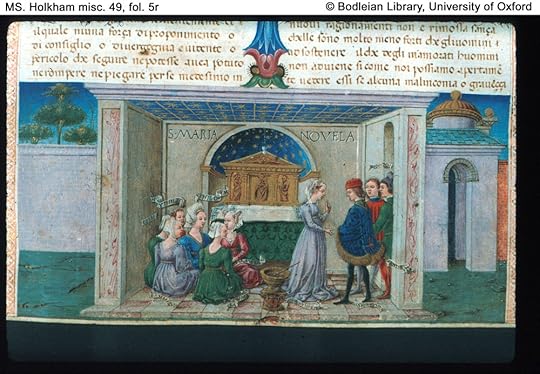
Big: http://www.bodley.ox.ac.uk/dept/scwms...
 A lovely poster for the Decameron by Ottavio Rodella Tavio (1864-1910) dated 1890 from Italy:
A lovely poster for the Decameron by Ottavio Rodella Tavio (1864-1910) dated 1890 from Italy:
http://gallica.bnf.fr/ark:/12148/btv1...
 BnF - ms Français 239 (est. 1430 in French)
BnF - ms Français 239 (est. 1430 in French)« Livre appelé Decameron , aultrement surnommé le Prince Galeot », de « JEHAN BOCCACE », traduction exécutée sur une traduction latine par « LAURENT DE PREMIERFAIT »
Full manuscript (downloadable): http://gallica.bnf.fr/ark:/12148/btv1...

Big: http://gallica.bnf.fr/ark:/12148/btv1...
Details of the manuscript: (view spoiler)
 BnF - ms italien 63 (1427 in Italian)
BnF - ms italien 63 (1427 in Italian)copied & illuminated by Ludovico Ceffini in Florence:
http://gallica.bnf.fr/ark:/12148/btv1...

http://gallica.bnf.fr/ark:/12148/btv1...
 Biblioteca Apostolica Vaticana (Vatican Library) - Pal.lat.1989 (c. 1414 in French)
Biblioteca Apostolica Vaticana (Vatican Library) - Pal.lat.1989 (c. 1414 in French)Manuscript of "La première traduction française du Decameron: le ms. Paris, BNF, fr. 239 et la nouvelle de Iancofiore (VIII, 10)"
http://digi.vatlib.it/view/bav_pal_la...
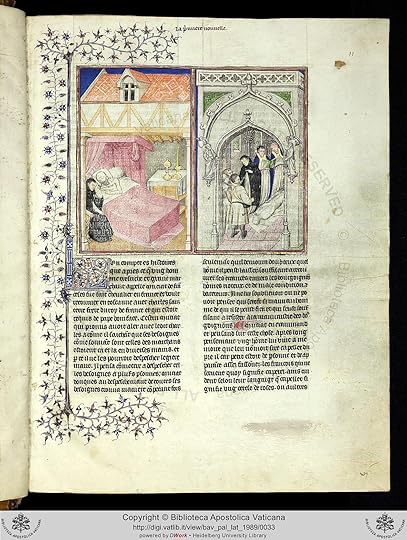
Big: http://digi.vatlib.it/diglitData/imag...
 Berlin Staatsbibliothek - Ms. Ham. 90 (1370, in Italian)
Berlin Staatsbibliothek - Ms. Ham. 90 (1370, in Italian)Copied and illustrated with 13 small ink drawings by Boccaccio himself:
http://digital.staatsbibliothek-berli...

Big: http://ngcs.staatsbibliothek-berlin.d...
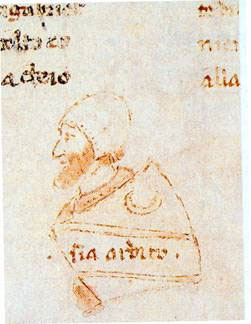
ms. Hamilton 90, c. 55v.
More (view spoiler)
For a bit more on the manuscript:
http://www.internetculturale.it/openc...
 BnF - ms italien 482 (1365-67, in Italian)
BnF - ms italien 482 (1365-67, in Italian)The crown jewel of all Decameron manuscripts, copied by Giovanni d’Agnolo Capponi and illustrated with 17 shaded pen drawings by Boccaccio himself, is sadly not available online (yet?) but I found some images (and will continue to collect them here).

Bibliothèque Nationale de France, ms. It. Parigino 482, c. 55r.
More (view spoiler)
For a bit more on the manuscript:
http://www.internetculturale.it/openc...
 1913 Formiggini illustrated Edition
1913 Formiggini illustrated Edition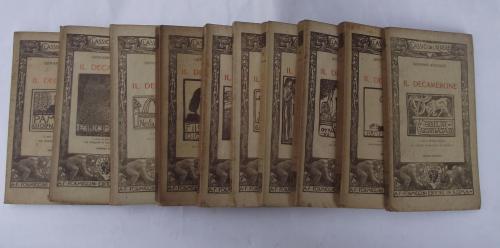
In 1913 the Genoese publishing house Formiggini released a ten-volume edition of the Decameron, edited by Ettore Cozzani.
Each volume was accompanied by woodcuts by various artists:
Emilio Mantelli (volume I), Giovanni Governato (II), G. C. Sensani (III), Carlo Guarnieri (IV e V), Armando Cermignani (VI), Antonio Moroni (VII), Pietro Dodero (VIII), Benvenuto M. Disertori (IX) and Mario Mossa De Murtas (X).
http://torresani-edu.blogspot.fr/2013...
Illustrations by Benvenuto M. Disertori for volume IX:
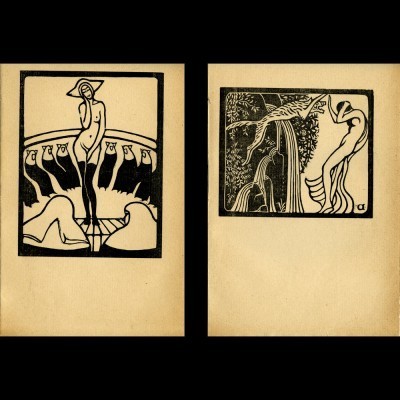

and by Mario Mossa De Murtas for volume X:

 DL wrote: "I love the pictures of the illuminated books."
DL wrote: "I love the pictures of the illuminated books."Me too! I'm collecting the sources here and then I'll try to paste the relevant illustrations story by story in the weekly threads. :)
 Illustrations from a 1545 edition in Middle French
Illustrations from a 1545 edition in Middle FrenchLe Decameron de Messire Jehan Boccace Florentin, nouvellement traduict d'italien en françoys par Maistre Anthoine le Macon, conseiller du Roy et trésorier de l'extraordinnaire de ses guerres published by Estienne Roffet dit le Faucheur in Paris in 1545
10 illustrations (one per day):
* illustrations only (poor quality): http://gallica.bnf.fr/ark:/12148/btv1...
* full book (better quality): http://gallica.bnf.fr/ark:/12148/btv1...
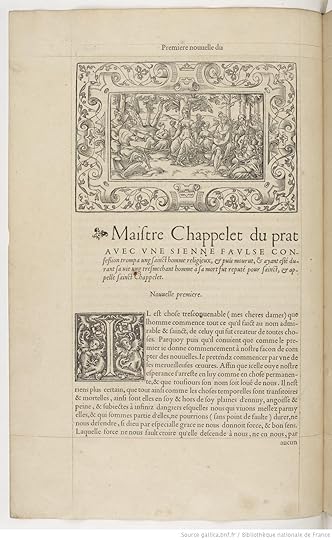
Big:http://gallica.bnf.fr/ark:/12148/btv1...
More (view spoiler)
{merci Yann!}
 Illustrations by Gravelot & others (1757)
Illustrations by Gravelot & others (1757)The illustrated Decamerone (published in Paris, with imprint: Londra, 1757) is a coveted edition in 5 volumes containing 89 plates, 97 tailpieces and 111 headpieces designed by Gravelot, François Boucher, Eisen and Charles-Nicolas Cochin.
A more recent edition (different translation) with the illustrations:
http://gallica.bnf.fr/ark:/12148/bpt6...

http://gallica.bnf.fr/ark:/12148/bpt6...
(view spoiler)
The drawings for Gravelot's illustrations are available from the Library of Congress:
http://lcweb2.loc.gov/cgi-bin/ampage?...
On Gravelot: http://en.wikipedia.org/wiki/Hubert-F...
{merci Yann!}
 Illustrations by Louis Chalon (1903)
Illustrations by Louis Chalon (1903)The Decameron of Giovanni Boccaccio / faithfully translated by J.M. Rigg ; illustrated by Louis Chalon (15 photogravures) (1903) in 2 volumes



http://www.rookebooks.com/product?pro...
and http://www.rookebooks.com/product?pro...
http://catalog.hathitrust.org/Record/...
One might wonder if these are not illustrations for the Arabian Nights!
Book Portrait wrote:
One might wonder if these are not illustrations for the Arabian Nights!
They do look exactly like them! You've been busy BP! Ihad trouble posting the imagess, so I'll just leave the link.
Plague and the Medieval Triumph of Death, Palazzo Abatellis, Palermo
Since the ‘Triumph of Death’ painting is at least a full generation later than Giovanni Boccaccio’s Decameron, whose literary context is a group of Florentine nobility who have fled Florence to the country for their ten-day sojourn to escape the scale of urban death as a frame for the stories related, this painting may even be a depiction meant to illustrate or reference the Decameron, especially given the circle of seven young noble women and three young men at the right of the painting as framed in Boccaccio’s collection of tales: “recounted in ten days by an honorable company of seven ladies and three young men in the time of the late mortal pestilence”. [8] Boccaccio (1313-75) lived through the Black Death of 1347-51 and was also highly aware of Palermitan wealth and power as he describes its prestigious trade in silk and pearl-laden citizens in his tales, most of whom like the citizens of Florence would be mowed down by plague if they were unable to escape in time to the healthier countryside. Although their lives did not overlap, both Pisanello and the earlier Boccaccio spent considerable time in Florence and while Boccaccio traveled to Palermo, Pisanello also had high favor in the court of Alfonso of Aragon, King of the Two Sicilies who governed from Naples and Palermo. Pisanello appears to have spent the rest of his life after 1448 in Naples and Palermo.
http://www.electrummagazine.com/2012/...
http://www..."
One might wonder if these are not illustrations for the Arabian Nights!
They do look exactly like them! You've been busy BP! Ihad trouble posting the imagess, so I'll just leave the link.
Plague and the Medieval Triumph of Death, Palazzo Abatellis, Palermo
Since the ‘Triumph of Death’ painting is at least a full generation later than Giovanni Boccaccio’s Decameron, whose literary context is a group of Florentine nobility who have fled Florence to the country for their ten-day sojourn to escape the scale of urban death as a frame for the stories related, this painting may even be a depiction meant to illustrate or reference the Decameron, especially given the circle of seven young noble women and three young men at the right of the painting as framed in Boccaccio’s collection of tales: “recounted in ten days by an honorable company of seven ladies and three young men in the time of the late mortal pestilence”. [8] Boccaccio (1313-75) lived through the Black Death of 1347-51 and was also highly aware of Palermitan wealth and power as he describes its prestigious trade in silk and pearl-laden citizens in his tales, most of whom like the citizens of Florence would be mowed down by plague if they were unable to escape in time to the healthier countryside. Although their lives did not overlap, both Pisanello and the earlier Boccaccio spent considerable time in Florence and while Boccaccio traveled to Palermo, Pisanello also had high favor in the court of Alfonso of Aragon, King of the Two Sicilies who governed from Naples and Palermo. Pisanello appears to have spent the rest of his life after 1448 in Naples and Palermo.
http://www.electrummagazine.com/2012/...
http://www..."
 ReemK10 (Paper Pills) wrote: "You've been busy BP! Ihad trouble posting the imagess, so I'll just ..."
ReemK10 (Paper Pills) wrote: "You've been busy BP! Ihad trouble posting the imagess, so I'll just ..."No snoozing Reem! :P
I'll have to read that article later but it looks excellent! Thanks. :) Here are some of the illustrations:

Triumph of Death Wall Painting, ca. 1448, Palazzo Abatellis, Palermo (Photo Rob Cook, 2012)

Map of Bubonic Plague – ‘Black Death’ 1347-51 (Photo courtesy of Encyclopedia Britannica, 1994)

Dead Prelates and Clerics – note where arrows protrude from lymphatic areas

Ten nobles in Death’s Path, possibly Decameron related

Young Female Nobles, one Stricken, two Watching – note where arrows protrude from lymphatic areas
In the book on the Plague I was reading last week they explained that very early on the arrow became the main symbolic representation for the Plague (in the Four Horsemen of Saint John's Apocalypse, the one bringing the Plague carries a bow).
 A couple of articles which might be interesting in relation to the Plague & the Apocalypse:
A couple of articles which might be interesting in relation to the Plague & the Apocalypse:http://academic.mu.edu/meissnerd/4hor...
http://en.wikipedia.org/wiki/Four_Hor...
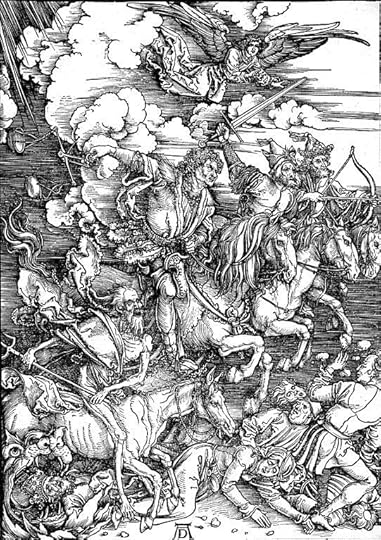
Dürer - The Revelation of St John: 4. The Four Riders of the Apocalypse (1497)
http://en.wikipedia.org/wiki/File:Dur...
 Yann wrote: "Fantastic! Thanks BP, for these beautifull illustrations."
Yann wrote: "Fantastic! Thanks BP, for these beautifull illustrations."Je t'en prie. :) I couldn't find where you had posted all those other links but after searching a little I found them and am going to post them here. Thanks buckets for those. :)
 Yann found several illustrated books (not manuscripts) with beautiful engravings:
Yann found several illustrated books (not manuscripts) with beautiful engravings:Les cent nouvelles (1486) {my personal favorites}:
http://gallica.bnf.fr/ark:/12148/btv1...

Raphaël (1504):
http://gallica.bnf.fr/ark:/12148/btv1...
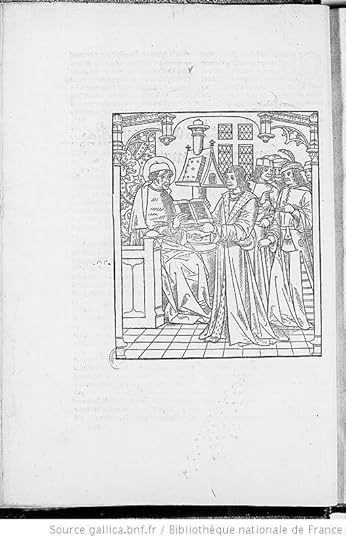
La complainte de Flamette(1532) {not the Decameron but gorgeous all the same!}:
http://gallica.bnf.fr/ark:/12148/btv1...
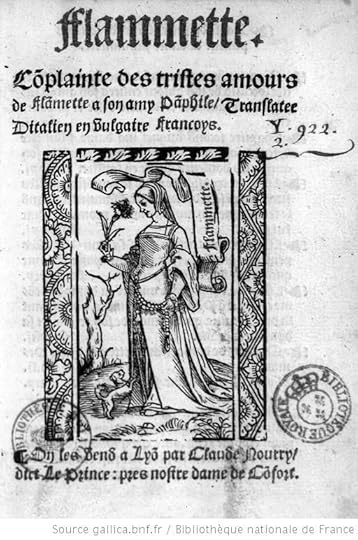
Rogier (1835):
http://gallica.bnf.fr/ark:/12148/btv1...
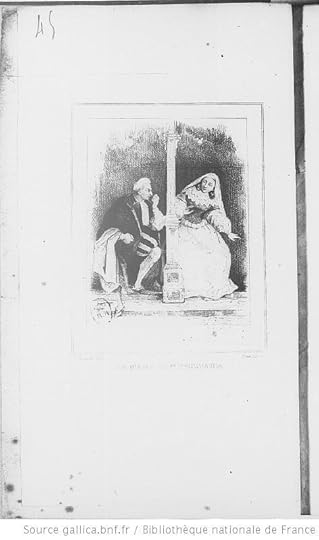
Johannot, Tony (1869):
http://gallica.bnf.fr/ark:/12148/btv1...

{merci Yann!}
 Book Portrait wrote: "Yann found several illustrated books (not manuscripts) with beautiful engravings:
Book Portrait wrote: "Yann found several illustrated books (not manuscripts) with beautiful engravings:Avec plaisir. But Flamette is part of Decameron, isn't she?
 I'm not sure. I thought it was a separate story. But I'm also under the impression that Boccaccio incorporated some of his previous stories in the Decameron. I might be wrong... I only just started his biography...
I'm not sure. I thought it was a separate story. But I'm also under the impression that Boccaccio incorporated some of his previous stories in the Decameron. I might be wrong... I only just started his biography...
Book Portrait wrote: "I'm not sure. I thought it was a separate story. But I'm also under the impression that Boccaccio incorporated some of his previous stories in the Decameron. I might be wrong... I only just started..."
Yes to both. There is The Elegy of Lady Fiammetta and the character in the Decameron.
Yes to both. There is The Elegy of Lady Fiammetta and the character in the Decameron.
 Kalliope wrote: "Yes to both. There is The Elegy of Lady Fiammetta and the character in the Decameron. "
Kalliope wrote: "Yes to both. There is The Elegy of Lady Fiammetta and the character in the Decameron. "Thanks! I'm wondering if the "cent nouvelles" (1486) is the same as the Decameron or not. The illustrations don't seem to match the first five stories:
1: http://gallica.bnf.fr/ark:/12148/btv1...
2: http://gallica.bnf.fr/ark:/12148/btv1...
3: http://gallica.bnf.fr/ark:/12148/btv1...
4: http://gallica.bnf.fr/ark:/12148/btv1...
5: http://gallica.bnf.fr/ark:/12148/btv1...
What do you think?
 BnF - Bibliothèque de l'Arsenal, Ms-5070 réserve (XV century)
BnF - Bibliothèque de l'Arsenal, Ms-5070 réserve (XV century)Another illuminated treasure from the BnF:
http://gallica.bnf.fr/ark:/12148/btv1...

http://gallica.bnf.fr/ark:/12148/btv1...
Book Portrait wrote: "Kalliope wrote: "Yes to both. There is The Elegy of Lady Fiammetta and the character in the Decameron. "
Thanks! I'm wondering if the "cent nouvelles" (1486) is the same as the Decameron or not. T..."
The little text I have read seems a different one too. Most peculiar.
Thanks! I'm wondering if the "cent nouvelles" (1486) is the same as the Decameron or not. T..."
The little text I have read seems a different one too. Most peculiar.
Book Portrait wrote: "ReemK10 (Paper Pills) wrote: "You've been busy BP! Ihad trouble posting the imagess, so I'll just ..."
No snoozing Reem! :P
I'll have to read that article later but it looks excellent! Thanks. :)..."
Oh thanks for posting the images. I could only get the last two to stick, so I scrapped the whole post and left the link! You're doing an awesome job!!
No snoozing Reem! :P
I'll have to read that article later but it looks excellent! Thanks. :)..."
Oh thanks for posting the images. I could only get the last two to stick, so I scrapped the whole post and left the link! You're doing an awesome job!!

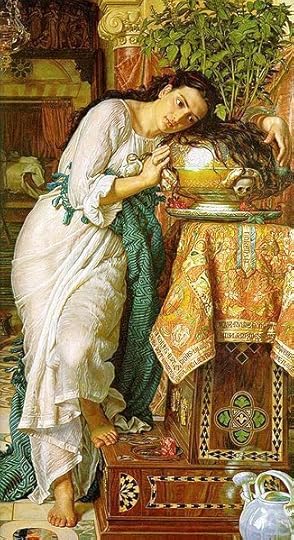
Isabella and the pot of basil, William Holman Hunt, 1867
The Fourth Day, the Fift Novell
http://commons.wikimedia.org/wiki/Fil...


View of Rhodos woodcut from Hartmann Schedel’s ''Weltchronik'' (Nürnberg 1493), fol. xxvi verso.
The Fift Day, the First Novell
http://en.wikipedia.org/wiki/File:Rho...


The Enchanted Garden of Messer Ansaldo, by Marie Spartali Stillman (1889)
The Tenth Day, the Fift Novell
http://en.wikipedia.org/wiki/File:The...
 The Story of Griselda (c. 1494)
The Story of Griselda (c. 1494)The Tenth Day, the Tenth Novell
by "Master of the Story of Griselda"
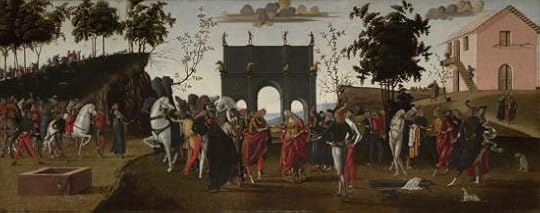
The Story of Griselda, Part I: Marriage
about 1494, Master of the Story of Griselda
http://www.nationalgallery.org.uk/pai...

The Story of Griselda, Part II: Exile
about 1494, Master of the Story of Griselda
http://www.nationalgallery.org.uk/pai...
http://en.wikipedia.org/wiki/File:Spa...
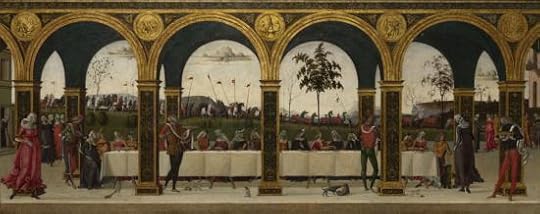
The Story of Griselda, Part III: Reunion
about 1494, Master of the Story of Griselda
http://www.nationalgallery.org.uk/pai...


A Vision of Fiammetta by Dante Gabriel Rossetti (1870)
http://pt.wikipedia.org/wiki/Ficheiro...
http://en.wikipedia.org/wiki/A_Vision...
Book Portrait wrote: "I'm not sure. I thought it was a separate story. But I'm also under the impression that Boccaccio incorporated some of his previous stories in the Decameron. I might be wrong... I only just started..."
Reading Boccaccio: A Critical Guide to the Complete Works, which provides a sort of survey/analysis of each of B's numerous works, there seems to be a Fiammetta in all of them... or at least in most...
Reading Boccaccio: A Critical Guide to the Complete Works, which provides a sort of survey/analysis of each of B's numerous works, there seems to be a Fiammetta in all of them... or at least in most...
 Book Portrait wrote: "
Book Portrait wrote: "View of Rhodos woodcut from Hartmann Schedel’s ''Weltchronik'' (Nürnberg 1493), fol. xxvi verso.
The Fift Day, the First Novell
http://en.wikipedia.org/wiki/File:Rho..."
Very interesting! I didn't knew this book.
http://en.wikipedia.org/wiki/Nurember...
Book Portrait wrote: "
The Story of Griselda, Part I: Marriage
about 1494, Master of the Story of Griselda
http://www..."
I like these Griselda panels.
The Story of Griselda, Part I: Marriage
about 1494, Master of the Story of Griselda
http://www..."
I like these Griselda panels.
 Kalliope wrote: "Reading Boccaccio: A Critical Guide to the Complete Works, which provides a sort of survey/analysis of each of B's numerous works, there seems to be a Fiammetta in all of them... or at least in most... "
Kalliope wrote: "Reading Boccaccio: A Critical Guide to the Complete Works, which provides a sort of survey/analysis of each of B's numerous works, there seems to be a Fiammetta in all of them... or at least in most... "Indeed! I wonder who the real Fiammetta was... maybe it was Boccacio's own "Beatrice"? This morning as I was posting the illustrations I came across this wiki page on Fiammetta that lists Boccaccio's works that include a character named Fiammetta:
http://en.wikipedia.org/wiki/Fiammetta
Aha! The wiki article says "Fiammetta, Fiametta (Italian for little flame)— pseudonym of Giovanni Boccaccio's beloved and muse, her real name may have been Maria d’Aquino"... Definitely something to look into! ^.^
 Yann wrote: "Very interesting! I didn't knew this book.
Yann wrote: "Very interesting! I didn't knew this book.http://en.wikipedia.org/wiki/Nurember... "
I didn't know it either! Thanks for tracking it down!! It seems the book is available online (squeee!) and it's incredibly beautiful. I know how I'm going to "perdre mon temps" this afternoon. ^.^
 Book Portrait wrote: "It seems the book is available online (squeee!) and it's incredibly beautiful."
Book Portrait wrote: "It seems the book is available online (squeee!) and it's incredibly beautiful."Yes, it's really jaw-dropping!
 Kalliope wrote: "Book Portrait wrote: "
Kalliope wrote: "Book Portrait wrote: "The Story of Griselda, Part I: Marriage
about 1494, Master of the Story of Griselda
http://www..."
I like these Griselda panels."
I do to. Of course, I could send for a reproduction but where would I put it!
 A "Boccaccio circa 1410" Pinterest page:
A "Boccaccio circa 1410" Pinterest page:http://www.pinterest.com/ladyshadow64...
I'll have to follow the leads and see which other manuscripts she's found! :)
 Another Pinterest page on Boccaccio:
Another Pinterest page on Boccaccio:http://www.pinterest.com/nenarok/giov...
And it seems it's possible to paste zoomed-in images from Gallica! I'll have to figure out how to do that! *gleeful nerd*
 Book Portrait wrote: "Another Pinterest page on Boccaccio:
Book Portrait wrote: "Another Pinterest page on Boccaccio:http://www.pinterest.com/nenarok/giov...
And it seems it's possible to paste zoomed-in images from Gallica! I'll have to figure out how to do that!..."
Like that ? :

http://gallica.bnf.fr/ark:/12148/btv1...
Use zoom, and select a part of image.
 Book Portrait wrote: "Ooooooh!!!!! Oui, like that!! Merci!!
Book Portrait wrote: "Ooooooh!!!!! Oui, like that!! Merci!!*giddy grateful nerd*"
Avec plaisir, but i am gratefull for the idea! ^^
Very nice! :)
In this book Florence: A Portrait, which I already mentioned in the Lounge, there is another passage referring to the Decameron. It is in reference to the frescoes painted by Guirlandaio in the Tornabuoni Chapel in Santa Maria Novella.
The quote:
And whatever the current deliberations of the Signoria about the requisite sobriety f women's dress, Guirlandaio's ladies flout them in low-cut bodices, ostentatious jewellery and brocades of pink and gold. The presence of these well-born and well-bred young women cannot help accidentally reminding us of the young women of the Decameron, who had met in the same church almost a century and a half before. p. 217.

The quote:
And whatever the current deliberations of the Signoria about the requisite sobriety f women's dress, Guirlandaio's ladies flout them in low-cut bodices, ostentatious jewellery and brocades of pink and gold. The presence of these well-born and well-bred young women cannot help accidentally reminding us of the young women of the Decameron, who had met in the same church almost a century and a half before. p. 217.

Raphael (his full name Raffaello Sanzio or Santi), 1483 to 1520, painter and architect of the Italian High Renaissance. Born in Urbino, in east central Italy, he is considered one of the three artistic giants to emerge from the Renaissance, along with Michelangelo and Da Vinci, both of whom served as his primary teachers. Raphael set himself deliberately to learn from Michelangelo the expressive possibilities of human anatomy, and from Leonardo his lighting techniques and sfumato (strong contrast between light and dark). But Raphael differed from Leonardo and Michelangelo, who were both painters of dark intensity and excitement, in that he wished to develop a calmer and more extroverted style that would serve as a popular, universally accessible form. His work is admired for its clarity and ease of composition, and for its achievement of the Neoplatonic ideal of human grandeur. Raphael is best known and loved for his Madonnas, and for his large figure compositions in the Vatican, but much focus has recently been given to the equally great Raphael of the portraits:
MOUNT PARNASSUS By Raphael

Erato, Ludovico Ariosto and Giovanni Boccaccio
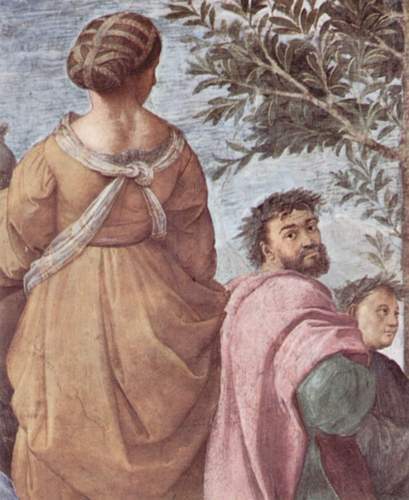
Homer flanked by Dante and Virgil

MOUNT PARNASSUS By Raphael

Erato, Ludovico Ariosto and Giovanni Boccaccio

Homer flanked by Dante and Virgil

Books mentioned in this topic
Florence: A Portrait (other topics)Boccaccio: A Critical Guide to the Complete Works (other topics)
The Elegy of Lady Fiammetta (other topics)
Le Décaméron (other topics)


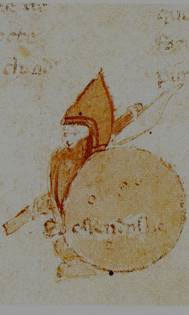
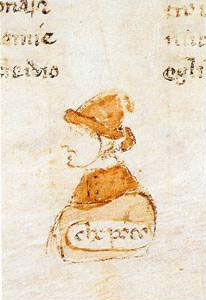
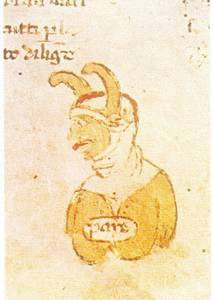
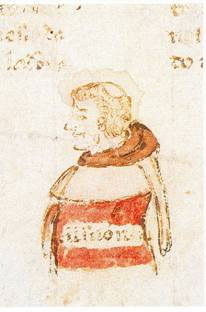
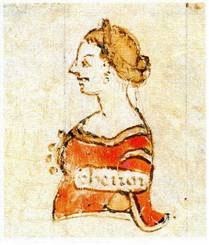
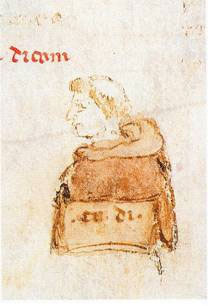
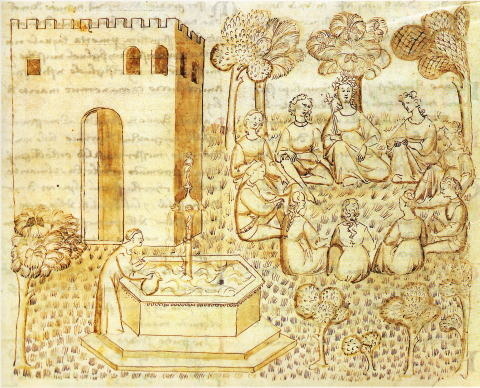



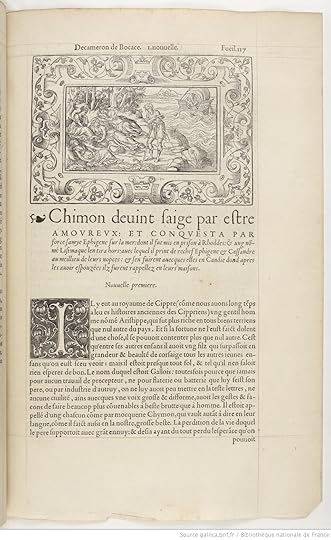
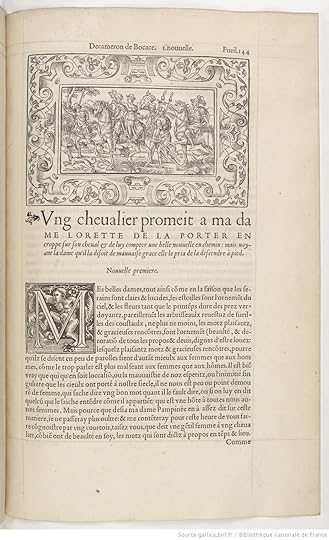
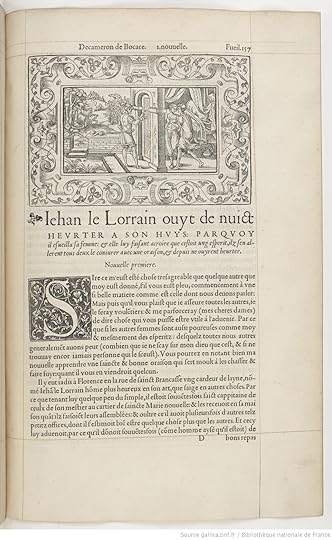

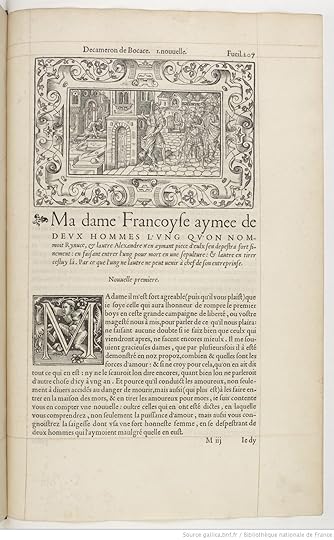



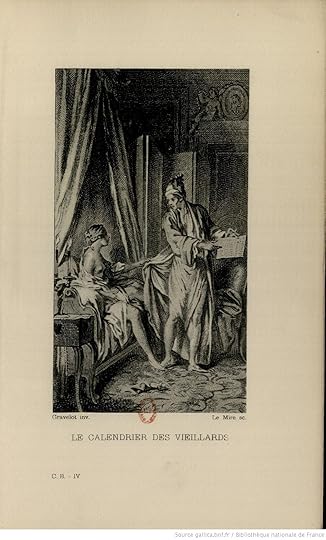





Big: http://www.college.columbia.edu/core/...
Cristofano dell'Altissimo, Portrait of Giovanni Boccaccio, 1568 (Galleria degli Uffizi in Florence)